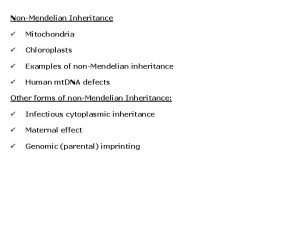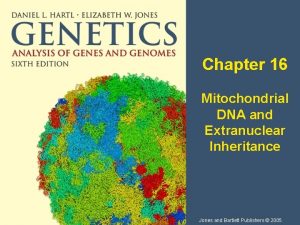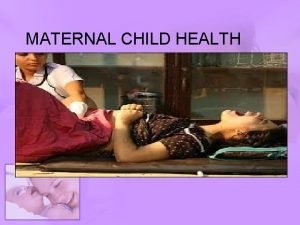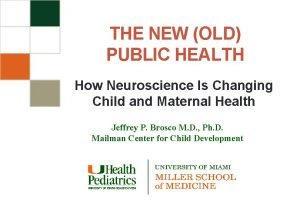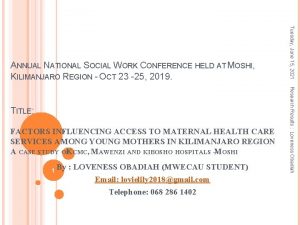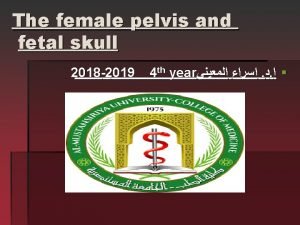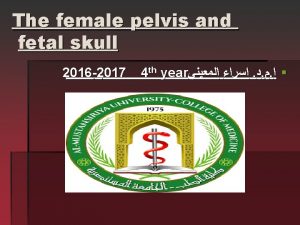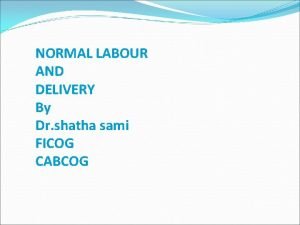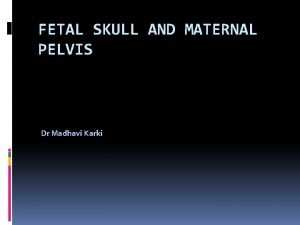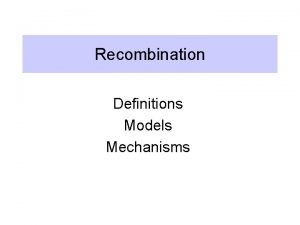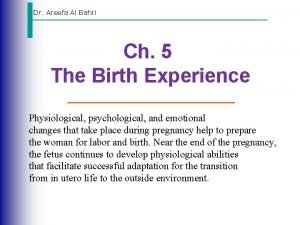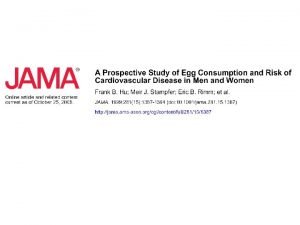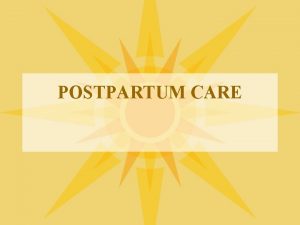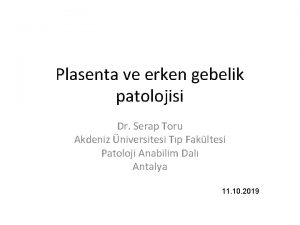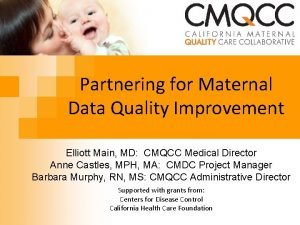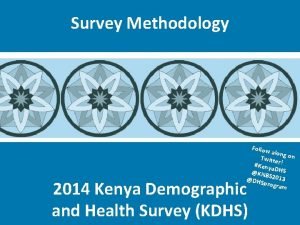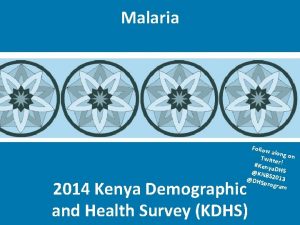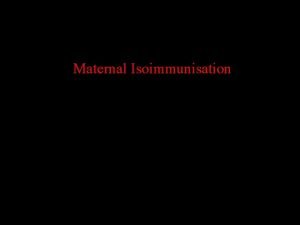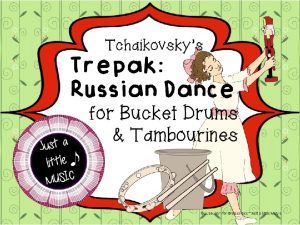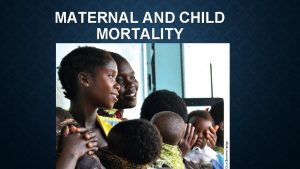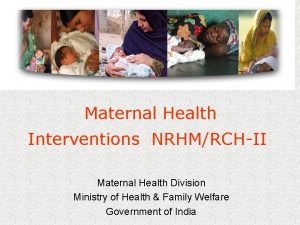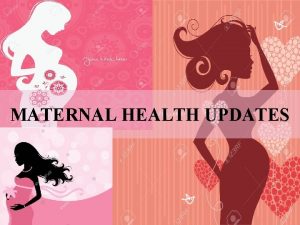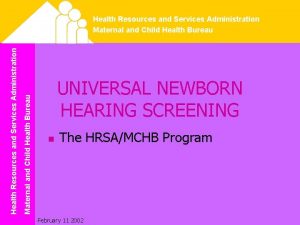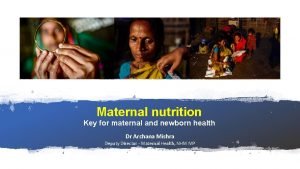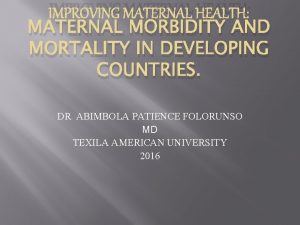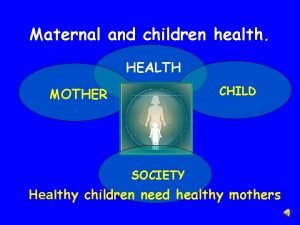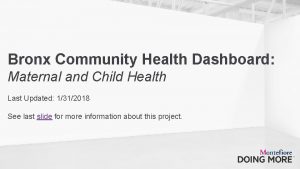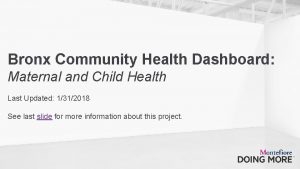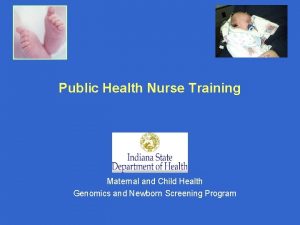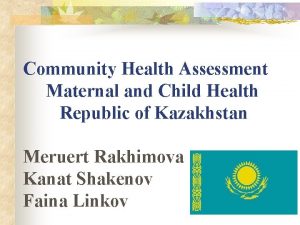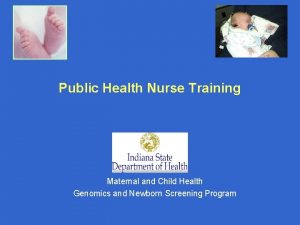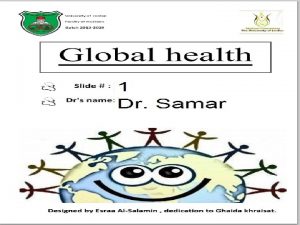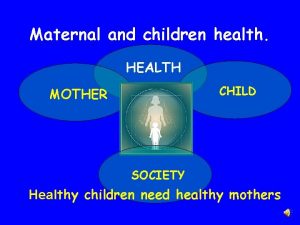Maternal and Child Health Follow along Twitte on


























- Slides: 26

Maternal and Child Health Follow along Twitte on #Keny r! a. D @KNB HS S @DHS 2013 progra m 2014 Kenya Demographic and Health Survey (KDHS)

Antenatal Care (ANC) • 96% of pregnant women with a birth in the past 5 years received ANC from a skilled provider. • 20% of women went to their first ANC visit during the 1 st trimester of pregnancy, as recommended. • 58% of women had 4 or more ANC visits.

Components of Antenatal Care Among women age 15 -49 who received ANC for most recent birth in the past 5 years, percent receiving the following services: Blood pressure measured 94 Blood sample taken 96 Urine sample taken 89 Given information on breastfeeding 68 Informed of signs of pregnancy complications 58 Among women age 15 -49 with a live birth in the past 5 years, percent who: Took iron tablets or syrup Took intestinal parasite drugs 69 31

Place of Delivery Percent distribution of live births in the five-year period before the survey 17 37 27 49 15 Home 8 Private sector facility Public sector facility 46 Total 55 41 Urban Rural

Delivery in a Health Facility by County Percent of live births in the five-year period before the survey Counties with < 35% health facility deliveries • Tana River • Marsabit • West Pokot • Samburu • Turkana • Wajir 32% 26% 25% 23% 18%

Delivery in a Health Facility by County Percent distribution of live births in the five-year period before the survey Counties with > 80% health facility deliveries • Kirinyaga • Kiambu • Nyeri • Nairboi • Nyandarua • Murang’a • Mombasa • Meru • Embu 93% 89% 86% 85% 82% 82%

Problems in Accessing Health Care Percent of women age 15 -49 who report the following problems in accessing health care for themselves when they are sick: Getting permission to go for treatment Not wanting to go alone Distance to health facility Getting money for treatment At least one problem accessing health care 6 11 23 37 46

Maternal Mortality • Maternal mortality includes all deaths that occur during pregnancy, during birth, and up to 2 months after birth or the end of the pregnancy. • Maternal mortality ratio (MMR) for the 7 -year period before the survey = 362 deaths per 100, 000 live births (CI: 254, 471)

Mortality and Child Health 2014 Kenya Demographic and Health Survey (KDHS)

Childhood Mortality Rates Deaths per 1, 000 live births for the five-year period before the survey 52 39 22 Neonatal mortality 16 Postneonatal mortality 14 Infant mortality Child mortality Under-5 mortality

Childhood Mortality by Mother’s Education Deaths per 1, 000 live births for the 10 -year period before the survey No education Primary complete 51 36 40 Infant mortality Secondary+ 56 40 Under-5 mortality 51

Trends in Childhood Mortality Deaths per 1, 000 live births for the five-year period before the survey 115 74 Under-5 mortality 77 52 52 Infant mortality 2003 KDHS 2008 -09 KDHS 39 2014 KDHS

Maternal Factors Associated with High Risk of Childhood Mortality Children are at an elevated risk of dying if: • Too short birth interval: less than 24 moths after a previous birth • Mother is “too young” (under 18) or “too old” (over 40) • High birth order: mother has four or more children

Childhood Mortality by Previous Birth Interval Deaths per 1, 000 live births for the 10 -year period before the survey < 2 years 3 years 4+ years 83 60 53 36 29 Infant mortality 36 42 Under-5 mortality 44

Childhood Mortality by Birth Order Deaths per 1, 000 live births for the 10 -year period before the survey 1 2 to 3 4 to 6 57 43 36 42 Infant mortality 48 7+ 62 49 Under-5 mortality 65

Trends in Basic Vaccination Coverage Percent of children age 12 -23 months with all basic vaccinations 79 77 79 2008 -09 KDHS 2014 KDHS 65 57 1993 KDHS 1998 KDHS 2003 KDHS

Basic Vaccination Coverage by Mother’s Education Percent of children age 12 -23 months who have received all basic vaccinations 84 87 75 57 No education Primary incomplete Primary complete Secondary+

Acute Respiratory Infection (ARI) In the 2 weeks before the survey, 9% of children under 5 were ill with cough and rapid breathing, symptoms of ARI. Among these children: • 66% were taken to a health facility or provider for advice or treatment. • 53% of these children received antibiotics.

Diarrhoea In the 2 weeks before the survey, 15% of children under 5 had diarrhoea. • Among these children, 58% were taken to a health facility or provider for advice or treatment.

Nutrition 2014 Kenya Demographic and Health Survey (KDHS)

Early Breastfeeding • Provides a newborn with colostrum, a key supplement for the infant’s immune system. • 62% of newborns are breastfed within the first hour of life, and 91% within the first day. • 16% of newborns are given food or liquid other than breastmilk (prelacteal feed), although this is not recommended. • 99% of infants are ever breastfed.

Exclusive Breastfeeding by Age Percent of children exclusively breastfed 84 63 61 42 0 to 1 4 2 to 3 4 to 5 Age in months 0 to 5

Duration of Breastfeeding Median duration of breastfeeding in months among children born in the last three years 21 3. 3 5 Any breastfeeding Exclusive breastfeeding 4. 4 Predominant breastfeeding

Nutritional Status of Children Percent of children under 5 Moderate Stunted (too short for age) Wasted (too thin for height) Underweight (too thin for age) 15 18 Severe 8 26 3 1 4 9 2 11 *Based on the 2006 WHO Child Growth Standards

Stunting among Children by County Percent of children under 5 • • Counties > 33% Kitui West Pokot Kilife Mandera Bomet Tharaka-Nithi Narok 46% 39% 36% 33% • • • Counties < 18% Kirinyaga 17% Nairobi 17% Garissa 16% Kiambu 16% Nyeri 15% *Based on the 2006 WHO Child Growth Standards 16

Trends in Nutritional Status of Children Percent of children under 5 38 36 35 Stunted 26 18 16 16 Underweight 7 6 7 1998 KDHS 2003 KDHS 2008 -09 KDHS Wasted 11 4 2014 KDHS
 Maternal effect and maternal inheritance
Maternal effect and maternal inheritance Extranuclear inheritance
Extranuclear inheritance Twitte
Twitte History of maternal and child health
History of maternal and child health Maternal and child health services
Maternal and child health services National programmes
National programmes Z score for malnutrition
Z score for malnutrition Maternal and infant health disparities
Maternal and infant health disparities I follow you wherever you go
I follow you wherever you go Factors influencing maternal health
Factors influencing maternal health What is maternal health
What is maternal health Poems about teamwork
Poems about teamwork Overvariation
Overvariation Chapter 15 maternal and fetal nutrition
Chapter 15 maternal and fetal nutrition Sacrosciatic notch
Sacrosciatic notch Clinical pelvimetry
Clinical pelvimetry Labour normal
Labour normal N
N Submentobregmatic
Submentobregmatic Holliday junction
Holliday junction Brow presentation
Brow presentation Health professionals follow-up study
Health professionals follow-up study Left child right child tree representation
Left child right child tree representation Lochia assessment
Lochia assessment Plasenta
Plasenta Pedigree shape meanings
Pedigree shape meanings Cmqcc data center
Cmqcc data center
